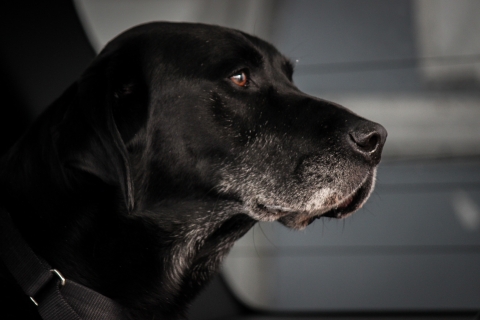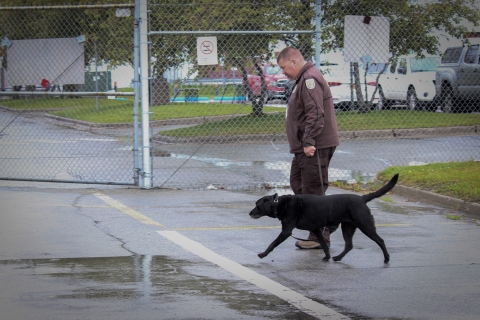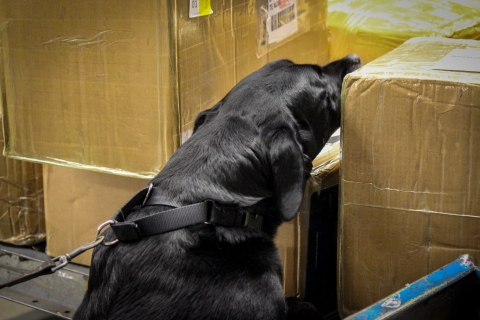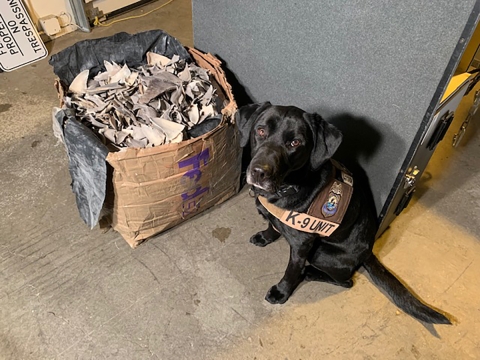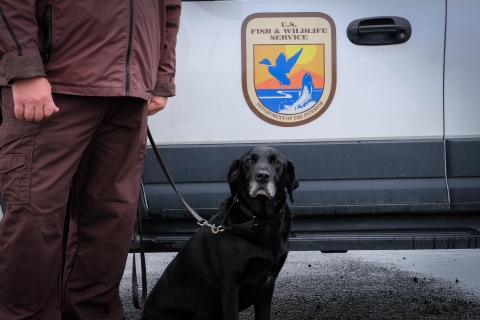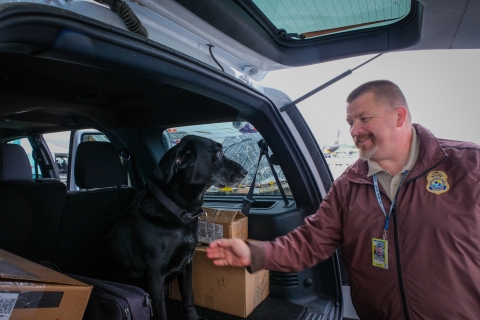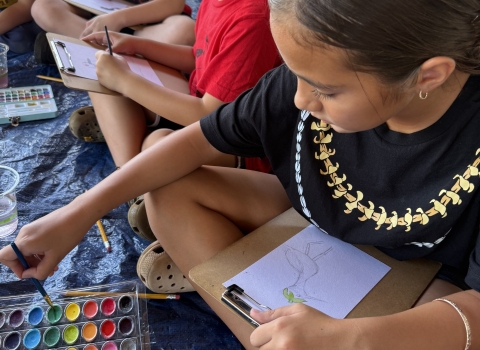Imagine: You're on duty as a Federal Wildlife Inspector, responsible for enforcing laws and regulations surrounding the importation and exportation of wildlife through U.S. ports. You walk through facilities covering acres of land with mountains of boxes and packages that are in constant movement, sorted to be placed in different aircraft with destinations around the world. Every day there are thousands of packages moving in and out of the Ted Stevens International Airport in Anchorage, Alaska. The task seems nearly impossible. Luckily for you and the handful of Federal Wildlife Inspectors stationed there, you have a secret weapon; the wet nose of a nine-year-old black Labrador: Dock.
The U.S. Fish and Wildlife Service’s Wildlife Inspector Canines come from the National Detector Dog Training Center (NDDTC) in Newnan, Georgia. The NDDTC works closely with animal shelters, rescue groups, and private owners to select dogs that are one to three years-old and have the intelligence and drive to work. Through this training course, dogs are trained to detect specific items hidden in boxes, vehicles, and other locations. The dogs selected for the Service are trained to detect the scents of species that are commonly trafficked in the illegal wildlife trade. They also must pass the American Kennel Club Canine Good Citizen Test, ensuring they have good manners and behavior around unfamiliar places, noises, people and other dogs. On average, 75 percent of the dogs successfully pass the training course. The dogs that do not meet the requirements are found a good home.
Born in 2014, Dock was brought to a Paulding County Animal Shelter in Georgia. “He was surrendered because he was a busy, active dog that didn’t fit the lifestyle of the owner,” says Katie Shipman, the adoption and rescue coordinator at Paulding County Animal Control. “It was very clear Dock was bored and causing mischief at home. He needed a job, so when the owner came to surrender [him], I immediately thought of the NDDTC. He had great food drive, was very confident, and I knew he would make a great canine officer.”
Dock worked his tail off and successfully passed the course. In 2016, Dock came to Alaska with his handler, Wildlife Inspector Chad Hornbaker. Since then, Dock has worked full time with Hornbaker in U.S. ports of entry within Alaska. Most of his time has been spent at the Ted Stevens International Airport, but multiple times per year he travels to the Alcan Port of entry on the Alaska-Canada border, working alongside U.S. Customs and Border Protection to detect wildlife and injurious invasive species invasive species
An invasive species is any plant or animal that has spread or been introduced into a new area where they are, or could, cause harm to the environment, economy, or human, animal, or plant health. Their unwelcome presence can destroy ecosystems and cost millions of dollars.
Learn more about invasive species , such as zebra and quagga mussels, on watercraft.
A day in the life of a Wildlife Inspector Canine starts with a good meal and an outside potty break. Some Wildlife Inspector Canines live in permanent boarding facilities, while others stay with their handler. Dock lives with his handler, Wildlife Inspector Hornbaker. On his way to work, Wildlife Inspector Canines such as Dock get specially outfitted vehicles that provide comfort and protection as they are transported around. In hot weather, these vehicles stay climate controlled to keep the working dogs comfortable.
Every day could be slightly different for Dock after arriving to the port of entry. Flight times of parcels moving in and out of Anchorage, flight times of international passenger flights, and sorting times at parcel hubs are all factors that could change Dock’s day. Usually, his shift starts off with a stroll through the airport to the U.S. Fish and Wildlife Inspector’s office at the North Terminal. Dock is met with greetings and smiles from all the staff there that have come to know and love him over the years. As Hornbaker walks through the terminal, heads pop over desks or around doorways to check if Dock is with him and provide some morning greetings and pets. In the office, impromptu training sessions sniffing out snacks and popcorn, hidden by fellow Wildlife Inspectors Tillman Graham and Brian Ohlen, were a regular occurrence.
Wildlife Inspector Chad states, “I’m just the guy at the end of the leash,” as people focus their attention on Dock.
Dock spent the majority of his workdays using his nose to detect wildlife items within parcels. He was walked through sorting facilities and used his nose to inspect hundreds of packages each day. Wildlife Inspectors work through large quantities of shipments, and sometimes identify packages that require inspection. With sometimes short turn arounds on the tarmac, Dock was accustomed to boarding planes and running through parcel containers for a quick check without delaying flights.
When a package is found to contain wildlife items, Wildlife Inspectors will determine if that item requires permits, or is lawfully allowed to be shipped and declared to USFWS. Many times, these items have the required permits and are allowed to continue to the shipment’s destination. Other times, Wildlife Inspectors work with the senders of the parcel to gather information and obtain the proper paperwork for the shipment. Then there are times where the item requires seizing, and is not allowed to continue to its destination. These items are often illegally acquired wildlife in violation of federal wildlife laws such as the Endangered Species Act , Lacey Act, Marine Mammal Protection Act, and the Indian Arts and Crafts Act to name a few. Dock’s work also helps Wildlife Inspectors enforce violations of the Convention on International Trade in Endangered Species of Wild Fauna and Flora (CITES).
Dock has had quite the track record with finds that sometimes even surprised his handler and other Wildlife Inspectors in the Alaska Region. To name a few, Dock has found python skin on designer shoes, gold-plated crocodile skin shoes, poison dart frogs, endangered cactus, packages full of shark fins, ginseng root from Shenandoah National Parks, walrus and elephant ivory, elephant skin, and even a package containing 17 turtles (15 of which were alive and saved).
Dock retired his federal service with the U.S. Fish and Wildlife Service, Office of Law Enforcement as a Wildlife Inspector Canine on October 19th, 2023. He had over seven years of honorable service and was one of the longest serving dogs from his class in Georgia. He has been adopted by his long-time handler and friend Wildlife Inspector Chad Hornbaker, who has now taken a Senior position in Alaska, no longer handling Wildlife Inspector Canines. Canines within the National Detection Dog Training program that end their federal service and those that cannot be adopted by their handlers are found good homes to which they retire.
Across the country U.S. Fish and Wild Service and its Office of Law Enforcement employs a hand full of Wildlife Inspector Canines. They serve as force multipliers and huge assets to the Office of Law Enforcement as parcel hubs continue to grow. For stations to employ a Wildlife Inspector Canine, a Wildlife Inspector must be available to attend his/her own training course as well as provide a long-term commitment fulfilling the role as a Wildlife Inspector Canine handler. These roles take time and resources outside the bounds of a normal Wildlife Inspector. The job, as many handlers such has Wildlife Inspector Chad Hornbaker would agree, is worth the work. Dock is not only a Retired Wildlife Inspector Canine, but he is part of the family.
For more information on the NDDTC and to learn how you can adopt a dog that has retired from service or did not meet the rigorous training requirements but would make wonderful pets visit National Detector Dog Training Center. In some instances, you don’t need to live close to the Center to adopt.

